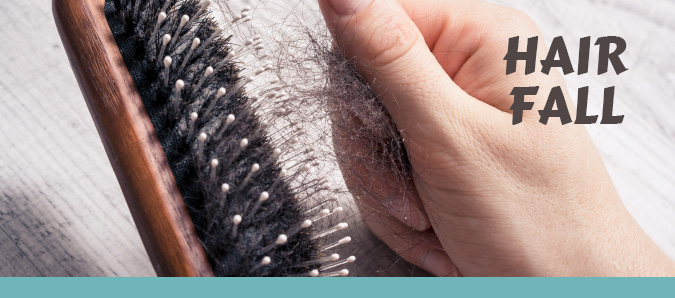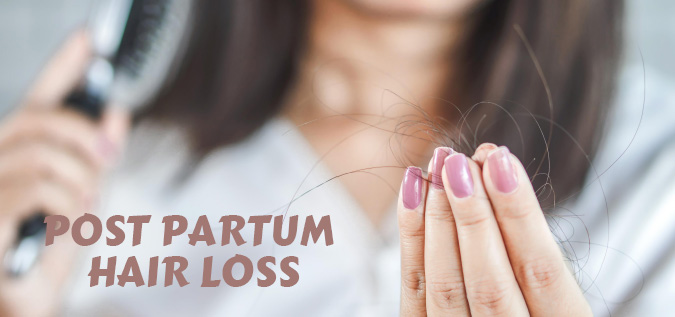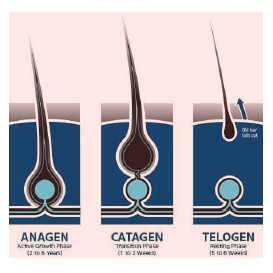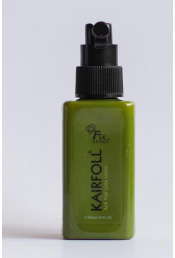 |
| Hair loss is a condition that causes the hair to fall out/shed excessively. It is normal to shed some hair
each day, people lose hair strand about 25 to 100 hairs every day. Human body continually grow new
hair and shed old hair. This shedding is not a sign of hair loss. If your hair begins to increase the rate of
shedding, dermatologist consider it hair loss or in medical term Alopecia.
Many people who have hair loss may develop one or more of these common signs mentioned
below depending on what’s causing your hair loss. People usually seeks cosmetic treatment
for hair loss rather than medical management. Most of the medicines available in the market
for the treatment of this hair condition can either stop or slow hair loss. |
|
|
| |
| Hair loss begins on the front, sides, crown of the head
and shows as receding hairline |
| Usually occurs due to physical or emotional shock.
This hair loss is related to the stress of the illness and
is temporary |
| Normally, certain area of the skin is itchy or painful
prior to hair falls out |
|
| |
|
| |
|
| |
Medical treatments such as chemotherapy causes
hair loss all over the body but usually grows back
after several months |
| |
One of most noticeable sign of hair loss may come out
when pulling, combing or washing the hair gently |
|
|
| World wide’s most common cause of hair loss, for both men and women is genetics. This type of hair loss is not
preventable. Commonly referred to as Male-pattern baldness and Female-pattern baldness. in medical term is
Androgenic Alopecia. Usually hereditary condition and it is considered to be one of the common types of hair losses
among adolescents and young. Almost 95% of men experiencing hair loss is due to androgenic alopecia; for female
the percentage is smaller. |
|
|
| |
| |
| \temporary |
| This leads to the hair becoming thinner and shorter with
each cycle. Depending on which type of Alopecia you
have, your age and the extent of hair loss; there are a
variety of treatment options available. The main goals of
treatment are to block the immune system attack and/or
stimulate the regrowth of hair. This can be effective,
especially for people with milder forms of the disease
(less than 50% hair loss).
For those who have more than 50% hair loss on their
scalp or other areas of the body, there are also oral and
topical medications available as well as photo therapy |
|
| |
|
| |
|
| |
Use wide tooth comb
Do not comb wet hair |
| |
Nutrients for hair is important for growth. Take vitamins and keep healthy diet. |
| |
|
| |
Avoid harsh chemicals that rob scalp of nutrients and that are not gentle to hair roots. Specialized shampoo recommended. |
| |
|
| |
Biotin and insositol are important hair ntrients that stengthen hair follicle. |
| |
|
| |
|
| |
Approach your dermatologist. It is better to arrest fall at the onset. |
|
|
|
 |
POST-PARTUM HAIR LOSS IS A
CONDITION THAT OCCURS AFTER GIVING
BIRTH AND USUALLY ACCOMPANIED
WITH SUDDEN SHEDDING OF THE HAIR.
WHEN A WOMAN IS PREGNANT HER
ESTROGEN AND PROGESTERONE
LEVELS INCREASE, PARTICULARLY
FROM THE SECOND TRIMESTER. THESE
HORMONES PLAY A HUGE ROLE IN
REGULATING HAIR GROWTH CYCLE.
NORMAL HAIR GROWS IN CYCLES AND
UNDERGOES THREE STAGES |
 |
|
 |
According to Dr. Sejal Shah (Dermatologist), “During pregnancy
there are lots of hormonal shifts happening and one thing that
those hormonal shifts do is promote hair growth," This means that
most of women’s hair stays in the growth phase in the course of
pregnancy and your hair is not shedding for several months. The
main reason behind this is due the excess estrogen and
progesterone developed during pregnancy wherein it encourages
the hair to enter growth phase – grow faster and shed less.
The good news is Post-partum hair loss is normal. “It’s very natural
process” says Dr. Shah. This hair condition usually can last up to 18
months after giving birth but most women return normal phases of
hair growth sooner. You’re not going to be bald!All bad things will
also come to an end. |
|
| |
|
| |
| |
With plant based
placenta protein
• Helps fight hair loss
• Reduce thinning and
• reverse slow growth
• Prevents the formation of
dandruff |
|
|
 |
| Inositol has been known to
reduce testosterone and
balance hormone which may
help everse thinning hair. A
diet lacking in inositol causes
baldness. |
Increases the elasticity of the
hair cortex preventing hair
breakage and thickens the
actual hair cuticle thus
increased diameter of the hair
shaft. |
Usually works in combination
with Vitamin H to rebuild,
strengthen individual hair
shafts and improve hair quality
at the follicle level by
maintaining its moisture level. |
|
| |